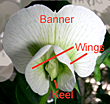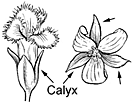Breadfruit
Artocarpus altilis
Mulberry/Fig family (Moraceae)
Polynesian introduction
Breadfruit, introduced by the early Hawaiians, is a handsome tree planted for its edible and attractive foliage. It is easily recognized by the very large, usually deeply 7–11- shiny dark green leaves, the yellowish green rounded or elliptical 4–8 inches (10–20 ) long, and the milky sap that exudes from cuts. The commonly cultivated Hawaiian variety is seedless.

©2012 Forest And Kim Starr
Leaves on very stout green leaf-stalks of 1–2 inches (2.5–5 ). Blades elliptical in outline, about 15–20 inches (38–51 ) long and 8–12 inches (20–30 ) wide, sometimes larger, the long-pointed, base short-pointed, thickened and leathery, upper surface nearly hairless except along veins, and lower surface lighter green and finely hairy at least on veins. Leaves of the seeded variety are less deeply usually have 9 or 11 instead of 7, and are more hairy.
Flowers are very numerous and minute, male and female on the same tree () in separate thick, fleshy clusters (heads) borne singly at leaf bases on stalks of about 2 inches (5 ). Male clusters are cylindrical or club-shaped soft masses about 5–12 inches (13–30 ) long and 1 inch (2.5 ) in diameter, yellowish and turning brown. Male flowers 1⁄16 inch (1.5 ) long, consisting of two- and one crowded on the outside. Female flower clusters are elliptical or rounded, about 2 1⁄2 inches (6 ) long and 1 1⁄2 inches (4 ) in diameter or larger, light green. Female flowers 3⁄8 inch (10 ) long and 1⁄16 inch (1.5 ) wide, composed of tubular cone-like pointed, hairy projecting 1⁄4 inch (6 ) and with sunken one-celled one-ovuled and two- Female flowers in seedless variety sterile and projecting only about 1⁄32 inch (1 ).
(multiple) are brownish, covered with individual and contain a whitish starchy pulp. surface in seeded variety is composed of greenish conical spine-like projections, each from 1 flower. Seeds are several large brown and edible. Seedless variety has smoothish surface honeycombed with individual about 3⁄16 inch (5 ) across. mature mainly from June to August in Hawaii.
Sapwood light yellow to yellowish brown; heartwood golden colored, sometimes flecked with orange. Wood very soft, lightweight ( gr. 0.27), but relatively strong for its weight. It is very susceptible to attack by dry-wood termites. There are numerous large pores but no growth rings. Rate of air-seasoning and amount of degradation are moderate. Machining characteristics are as follows: planing is fair; shaping, turning, boring, and mortising are very poor; sanding is poor; and resistance to screw splitting is excellent. The wood is suitable for boxes, crates, light construction, and toys.
Because of its lightness, Hawaiians used breadfruit wood for surfboards and canoe hulls. It is said to have been the preferred wood for the platform or deck between the hulls of large double-hulled canoes. A large drum was hollowed from a section of the trunk. An inferior grade of tapa or bark cloth was made from the bark.
are gathered before maturity and roasted or boiled as a starchy vegetable. Young can be sliced and fried, and the seeds boiled or roasted. A dessert and preserves can be made from the starchy male flower clusters. In Hawaii, breadfruit was not an important food but served partly to fatten hogs. This was probably because the Hawaiians had not introduced good varieties. In the Marquesas, whence the Hawaiians are believed to have emigrated, breadfruit was and still is the primary foodstuff of the people. There, it is made into a paste and fermented in pits into a cheese-like substance. Throughout Polynesia, it is eaten with a sauce made of coconut milk, seawater, and lime juice.
The trees are also attractive for ornament and shade. Elsewhere, cut foliage has served as forage for cattle during periods of drought. Rough leaves were used as sandpaper.
Special use of the sticky milky sap of breadfruit and certain other plants as bird lime has been told by Degener. Under instructions from King Kamehameha, the royal birdcatcher's captured certain small birds for their feathers of special colors. These rare feather colors were needed to decorate the precious war cloaks, helmets, and images. The black mamo bird, now extinct, had a small tuft of yellow feathers under each The glue was smeared on long baited poles which were placed where the birds would perch and become entangled. After the choice feathers were plucked and the feet of the birds carefully washed in oil or juice, the birds reportedly were released unharmed to grow more feathers!
According to a legend related by Degener, the chief Kahai brought the breadfruit tree to Hawaii from Samoa in the twelfth century and first planted it at Kualoa, Oahu. Only one variety was known in Hawaii, while more than 24 were distinguished by native names in the South Seas. Absence of the variety with seeds indicates that this species was not native. In Hawaii, the trees are found near dwellings or in lowland valleys at former homesites.
This tree was introduced by the British into the West Indies in 1793 from Tahiti of the South Sea Islands to provide cheap food for slaves. It was claimed that three or four mature trees could provide starchy food to support a person throughout the year. Captain William Bligh in the ship Providence chartered by the British Government brought plants to St. Vincent and Jamaica. This special expedition was undertaken to transport potted plants of the seedless variety the great distance. An earlier attempt with a cargo of plants on board the ship Bounty failed because of the famous mutiny against Captain Bligh in 1789. About the same time the French brought a few breadfruit trees to other islands of the West Indies.
Propagation is by root cuttings, suckers, or layering and in the seeded variety by seeds. Growth is rapid.
Common as a tree through the tropics, the seeded variety escaping from cultivation. In Puerto Rico and Virgin Islands, it is planted around homes and escapes occasionally. Rare in southern Florida, fruiting only at Key West.
In Hawaii, it is planted and in moist lowlands.
Special areas
Waimea Arboretum, Foster, City
Champion
Height 54 ft (16.5 ), c.b.h. 10.3 ft (3.1 ), spread 59 ft (18.0 ). Hilo Hotel, Hilo, Hawaii (1968).
Range
Native in South Pacific Islands, probably New Guinea, but planted through the tropics.
Other common names
panapen, arbol de pan, palo de pan, pan, pana (Puerto Rico, Spanish); dogdog (Guam); lemai (N. Marianas); arudo (Palau); maa (Yap); mai (Truk, Pohnpei); mohs (Kosrae); ma (Marshalls); ‘ulu (Am. Samoa)
Botanical
Artocarpus communis J. R. & G. Forst., A. incisus (Thunb.) L. f.








